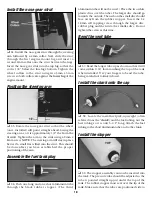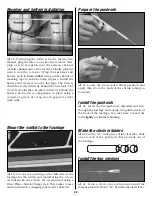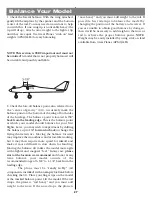
1. Turn on the Transmitter and then the Receiver.
Standing behind the plane, make the following
movements with the transmitter and observe the
control surfaces:
If any of the servo movements are opposite, reverse
the servo direction with the
servo reversing switches
on the transmitter.
2. For added
safety
and
convenience
, the throttle
should be set up so that the engine can be stopped
using the throttle trim. To do this, loosen the pushrod
connector screw and move the throttle pushrod so
that the carburetor is completely
closed
with the
throttle stick and trim lever on
the transmitter fully
back
.
(NOTE:
If the carburetor does
not fully close, adjust the idle
stop screw on the carburetor
until it will.) Next, tighten the
screw on the pushrod
connector. Test the trim lever
by advancing it to full. This will be a
fast idle position
with the carburetor barrel
slightly open (about 1/32”).
See sketch. Now move the
throttle stick forward to full.
Make sure that the carburetor
barrel opens
all the way
. See
sketch. If it doesn’t open far
enough or opens too far (bending the rod) move the
pushrod connector in or out on the servo arm and/or
the carburetor arm to gain or reduce movement. The
throw will be correct when the carburetor barrel will
stop fully open at the same time the throttle stick
reaches full. With the throttle set up properly, you
should be able to start and run the engine with the
trim lever set midway to full position (adjusted for a
smooth but slow idle). Then when it is time to stop
the engine, simply pull back the trim to close the
carburetor and the engine will stop running.
3. Check the movement of the control surfaces. Use a
ruler to match our measurements listed below. If your
radio features dual rates, set up both the high and the
low rates following the radio system’s instructions. If
your radio does not have dual rates, set up the plane
using the low rates first and increase the throws as
you get familiar with the plane.
Low rate
High rate
Aileron
3/8” up
1/2” up
1/4” down
3/8” down
Elevator
5/16” each way
7/16” each way
Rudder
5/8” each way
3/4” each way
These are the suggested deflections from center.
If you need more movement, you should move the
clevis to a hole closer to the surface or you can install
a larger servo wheel and move the rod further out
from center. If you have too much movement, do
the opposite. See sketches below:
4-CHANNEL
TRANSMITTER
4-CHANNEL
TRANSMITTER
4-CHANNEL
TRANSMITTER
4-CHANNEL RADIO SETUP
(STANDARD MODE 2)
TRANSMITTER
4-CHANNEL
ELEVATOR MOVES UP
RIGHT AILERON MOVES UP
LEFT AILERON MOVES DOWN
RUDDER MOVES RIGHT
CARBURETOR WIDE OPEN
26
Radio System Set-Up
Open Slightly (Idle)
Fully Open
Moving the clevis outward on the servo arm results in more
pushrod movement.
Moving the clevis inward on the control horn results in more throw.











































